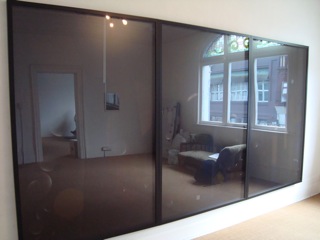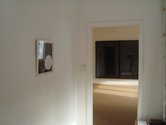Mark Amery – 11 April, 2010
The most aggressive thing about these works is how you're made acutely aware of the awkwardness of looking - peering in and shifting your placement to detect the colour modulations, trying to get past yourself staring back in the glass.
Wellington
Ava Seymour
Tree Songs
until 17 April 2010
Photographing Ava Seymour’s latest exhibition at Peter McLeavey’s is quite unnerving. These exquisite dark, dark works almost disappear when shot, lit only by natural light and the aura of McLeavey’s sole ancient domestic lighting fixture. Instead, as the above images well demonstrate, you and the room are reflected. The large triptych that dominates this exhibition comes to resemble a set of mirrored wardrobe sliding doors.
In the act of photographing a photograph of an enlarged collage behind glass, it is almost as if all these dimensions have neatly folded in on themselves like cubist origami. How aware was this experienced and subtle photo collagist of the effects of siting these works - created during Seymour’s recent McCahon House Residency in Titirangi - in these rooms?
The spectral spookiness of these work’s presence is echoed by their nocturnal mystery and play in abstraction with capturing light and the prismatic colour spectrum. As McLeavey noted on my visit, photography can be considered painting with light. Here in photographing A3 sized paper collages, blowing them up to figure height, and then placing them at a distance from us behind glass, Seymour plays adventurously and with a degree of complexity with painting and photographic techniques, and the space in between them.
Even up close the work is difficult to read, affected hugely in McLeavey’s space by what the sun is doing outside. The viewer and their environment’s reflection in the work appears a deliberate wish. The experience of looking at these works under direct light as most other galleries provide with their purpose-made gallery lighting systems (and as you can do here by holding up one small unhung work to the light) is radically different. The choice of McLeavey’s rooms to first show them sees their muted nocturnal softness amplified without any need to darken the space.
The McCahon residency studio is, I understand, surrounded by tall Kauri and Kahikatea, and to look at the large triptych here is to feel you could be sitting in a darkened space in the thick of the forest in the middle of the night. You appreciate for example the play of moonlight as it travels a dappled leafy path into your inner chamber, broken in its dimensional throw by tree trunks like cubist shards.
Suitably the exhibition is entitled Tree Songs, and I was immediately reminded of the immersion of McCahon’s large series The Wake. A poetic lament, it features the dim vertical strokes of the Kauri, and was completed at night on McCahon’s return to Titirangi from his visit to the States.
Like a midnight garden of musky perfumes, Seymour’s work is also a dreamy nocturne. Intensely musical, it is a work of dark sensual delights playing with a majestic but hazy rainbow of purples, greens, scarlets, gold and silver. Shadowy vertical bands and circles make the work resemble a dense thicket of musical notes on a giant stave. Yet, at the same time as having the microscopic immersion of prisms of light in the forest, the work is also suggestive of the cosmos.
The works are unusually, defiantly dark, demanding you to step up close and move across the surface to appreciate them. And just as you have to move to pick up shifts in the work against the glass surface glare, streams of circles have subtly lit edges from various different directions. These and Malevich-like small square patches provide pretty much the only strong lighting from within the work.
Those still hoping Seymour will return to the terrain of her punk figurative photo montages of the mid 90s are left wanting. Content is not at stake in the same way here. Instead the beauty of the montage and how it might see photography operate like abstract painting as visual music is explored.
The most aggressive thing about these works is how you’re made acutely aware of the awkwardness of looking - peering in and shifting your placement to detect the colour modulations, trying to get past yourself staring back in the glass. It’s irritating to be sure, but it sets up an interesting tension between viewer and abstraction. The reward is that this work manages to rise above its swish of the trails of modernism to encourage a new way of looking at photography and two dimensional work in general.
McLeavey’s rooms also come filled with other artists’ shadows. While McCahon’s influence is clear in the mood and size of the work, it’s devoid of his signs, symbols and personal questions. Formally its far more akin in rhythm and music to another McLeavey stablemate and collagist, Gordon Walters. This is particularly the case in four small works’ strong play with one or two circles and a wide vertical strip on another colour field. The vertical strip could again allude to the trees. The mood is nocturnal, lit dimly by the moon. The tension in these works lies in the delicacy with which Seymour plays with the edge of her cutout shapes, providing some bite in the formation of a dimensional space. Yet they don’t hold the mystery of the large triptych.
The work swims in the pool of modernist abstraction and the influences McCahon brought to bear on his work in Titirangi. Here you might find many echoes. The schemes and colour play of Sonia Delaunay and Kandinsky, the collage of Braque and Picasso, the shapes of Malevich and Mondrian, and mood boards of Rothko, all shifting across each other and rising up to the surface like bubbles. In this way the work is the most interesting consideration of abstract painting through photography, and indication of its painterly potential, I can recall




 Advertising in this column
Advertising in this column Two Rooms presents a program of residencies and projects
Two Rooms presents a program of residencies and projects



This Discussion has 0 comments.
Comment
Participate
Register to Participate.
Sign in
Sign in to an existing account.